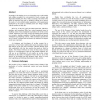Free Online Productivity Tools
i2Speak
i2Symbol
i2OCR
iTex2Img
iWeb2Print
iWeb2Shot
i2Type
iPdf2Split
iPdf2Merge
i2Bopomofo
i2Arabic
i2Style
i2Image
i2PDF
iLatex2Rtf
Sci2ools
SIGGRAPH
2003
ACM
2003
ACM
Forum: a new approach for the production of educational content
eLearning is developing at an ever increasing rate as universities and colleges recognize its vast potential to reach a deeper and fragmented student pool. For a while, eLearning was touted as the future of education, the goal we should be aiming for to answer the needs of a diversified student population with requirements predicated by the need to constantly learn new things coupled with the realities of daily life. However, as the rosy glow has faded somewhat, educators, students, and researchers alike, have raised important issues to challenge some of our assumptions as producers of on-line course content. Instructors cite a lack of time and training and concerns over security, students complain of feeling isolated and poorly stimulated by uninspiring content, while researchers question the use of “sacred” concepts such as interactivity and their real impact on the user experience. As designers and developers of on-line content for a university, we have had to address these iss...
| Added | 05 Jul 2010 |
| Updated | 05 Jul 2010 |
| Type | Conference |
| Year | 2003 |
| Where | SIGGRAPH |
| Authors | Christine Daviault, Marcelo Coelho |
Comments (0)

